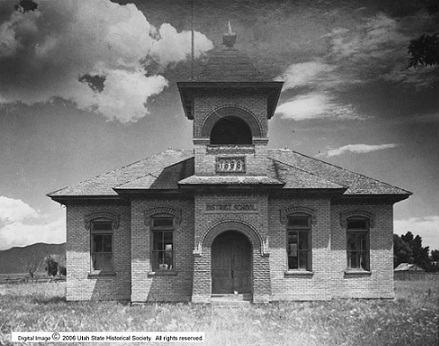Dublin Core
Title
Description
In Utah, one-room schoolhouses evolved into the publicly supported education system we have today. Utahns struggled to find an adequate solution to the question of education, and was the last territory in the nation to provide a free public school system.
The iconic one-room schoolhouse conjures images of western settlers struggling to create educational outposts on the frontier. But how did those one-room schoolhouses evolve into the publicly supported education system we have today?
Education in the Utah Territory began with schools established by Mormon pioneers in the late 1840s. Schools were run by Mormon congregations or by individuals who opened classrooms in their homes. Each school accommodated only a few students, the curricula varied in quality, and attendance was not mandatory. Some parents encouraged their children to get as much education as possible, while others doubted the need for anything beyond the rudiments. Many also questioned the level of religion that should be taught and who should pay for schools.
Newcomers to Utah thought the state of education was inadequate. Starting in the 1860s, Catholic and Protestant leaders established their own schools, both to improve education in the State and, in some cases, to “Christianize” the Mormon children. As more non-Mormons arrived, a movement grew to establish a system of free public education supported by taxes. Because of the Mormon Church’s emphasis on self-sufficiency, its leadership rejected the idea of public schools. They believed families should pay to educate their own children, while charity should help those who could not afford schooling. Some communities attempted to create a tax-supported school system, but faltered when many people refused to pay the tax. Despite these difficulties, loud calls for free public education continued.
Utah was the last territory in the nation to provide a free public school system. It wasn’t until 1890 that the Utah Territorial Legislature passed the Free Public School Act, which resulted in the creation of compulsory secular schools and the construction of “modern” school buildings. Many of the schoolhouses built before the Free Public School Act -- and as a result of it – still exist and stand as symbols of the early efforts to support education in Utah.
Creator
Source
Image: Fairfield School. The Fairfield District School, built in 1898, tells the story of change in Fairfield as well as early education in Utah as new groups of people moved into the state and populations changed. Courtesy of Utah State Historical Society.
_______________
See Buchanan, Frederick S., “Education in Utah,” Utah History Encyclopedia, accessed; Hough, C. Merrill, “Two School Systems in Conflict: 1867-1890,” Utah Historical Quarterly, Vol. 28 No. 2, April 1960; Ivins, S. S., “Free Schools Come to Utah,” Utah Historical Quarterly, Vol. 22 No. 4, October 1954; Moffitt, John Clinton, The History of Public Education in Utah, Provo, Utah, 1946; Van Leer, Twila, “Schools: They Went With the Territory,” Deseret News, July 3, 1994, accessed Utah Education Network; The Fairfield District Schoolhouse and Early Education in Utah, exhibit at Camp Floyd / Stagecoach Inn State Park, Fairfield, Utah, 2011.

